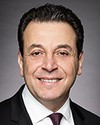Thank you very much, Mr. Chair.
Good afternoon to all the members of the committee. As was stated, my name is Jeff Hutchinson and I am the commissioner of the Coast Guard. I'm pleased to be here with Mario Pelletier, who is deputy commissioner of operations for the Coast Guard. It's our honour to be here as well with our very close partners from the armed forces and Transport Canada. We are pleased to have an opportunity, which is exciting as the chair noted, to discuss Canadian sovereignty, particularly as it relates to the Arctic and the roles of our respective organizations in the north.
Perhaps, to state the obvious, sovereignty can be a difficult term with both legal and geopolitical complexities. Today, my colleagues and I wish to focus on three aspects of sovereignty, which we hope you'll find useful in your deliberations. Those aspects are stewardship, security and safety, especially as it relates to regulation of activity in our north. I will elaborate on the Coast Guard's role, in particular, focusing on Arctic stewardship. My colleagues will touch on security and safety, respectively. We'll speak as if the Arctic mission and our Arctic presence is done in silos. In fact, it is important to underscore that our organizations work very closely together, knit together in a partnership that's effective, in our view.
The Canadian Coast Guard mandate includes authorities that put us in command of on-water search and rescue and environmental response. That goes with the responsibility of being a first responder. However, our mandate, especially in the Arctic, might better be captured by the idea of stewardship. Why do I connect stewardship and sovereignty? We care for what we value. We care for our own. It is the Canadian connection to the Arctic that drives us to protect a remote and fragile environment, to partner with people of ancient traditions, and to enable leading-edge science in a rapidly changing region.
Please allow me to be clear. I do not mean to say that the Coast Guard is the steward of the Arctic, not at all. We are but a steward in the Arctic. Major-General Seymour's views on the security of the Arctic and Ms. Weldon's views on the proper safe regulation of the Arctic both contribute to a robust view of how Canada expresses and exercises its sovereignty. I would contend that the Coast Guard's role in stewardship contributes to the same outcome.
The Canadian Coast Guard is regarded as a leader in Arctic issues. What does this mean in specific terms?
The Coast Guard provides marine domain awareness to federal partners such as the Armed Forces and Transport Canada through the Marine Communications and Traffic Services office in Iqaluit. That office maintains 24/7 operational awareness across the North American Arctic throughout the navigation season.
The Coast Guard deploys up to seven icebreakers to the Arctic, the majority of which are equipped with a helicopter, to ensure community resupply, to support Arctic science and to assist commercial shipping. Of course, these ships respond as needed to search and rescue and environmental response cases. Services include shipping escort, providing ice information and routing advice, harbour breakouts, flood control, and the supply of dry cargo and fuel to northern communities.
As of September 13 of this year, the Coast Guard has conducted 57 escorts and coordinated 30 search and rescue cases.
The Coast Guard is responsible for some 2,000 aids to navigation in the Arctic, including buoys, markers and radio towers, which we install and maintain to ensure safe shipping. The aids to navigation program assists marine navigation, determining positioning and course, warning of dangers or obstructions to navigation, and marking the location of preferred routes. We also contribute to Canada's marine domain awareness in the high latitudes by identifying and monitoring vessels in the area. Our base in Hay River in the Northwest Territories ensures a year-round northern presence with a focus on the Mackenzie River.
The Coast Guard maintains strong partnerships with indigenous people, who rely on our icebreakers to ensure the timely arrival of fuel, building materials, vehicles and all manner of goods that are uneconomical to carry by plane. We are fully committed to working with indigenous partners and stakeholders to ensure safe and secure marine shipping in the Arctic. We have a number of initiatives to support this engagement. For example, we have 15 community-based Canadian Coast Guard auxiliary units active at this time, with over 200 auxiliary members and 25 vessels. Those numbers are expected to continue to go up in 2019.
We're also building bases and training local people in search and rescue. On June 28, 2018, we opened a seasonal inshore rescue boat station in Rankin Inlet—the first of its kind in the north and crewed by Inuit youth—to enhance northern search and rescue capacity and to strengthen our relationships with these communities.
As an asset for the Government of Canada, our fleet has a long history of supporting enforcement activities of National Defence, the Royal Canadian Mounted Police, and other federal departments. The Coast Guard’s icebreakers also provide a mobile scientific platform for Canadian scientists in the Arctic.
In 2014 and 2015, we participated in Canada’s definition of its continental shelf for the Arctic Ocean by sending our icebreakers to the North Pole where they worked together to map these waters.
Thanks to the oceans protection plan, we're extending the operating season for Coast Guard ships working in the Arctic, allowing earlier resupply of fuel and other critical goods to northern communities. A longer shipping season also means greater economic opportunity for northerners looking to move goods to southern markets.
I might just note before concluding that the Coast Guard has also engaged in international co-operation, as it relates to the Arctic. Our principle forum being the Arctic Coast Guard Forum, where we participate with seven other Arctic nations at an operational level to make sure that coast guard organizations are working collaboratively to cover the vast distances that are common in the Arctic region.
Interest in the Arctic continues to rise as changing climate conditions are making the Canadian Arctic more accessible for marine traffic and economic development. More marine traffic means a greater risk of incidents. There is a misconception that melting ice makes it easier for vessels to navigate our northern waters. In fact, the unpredictability of broken ice floes adds to the risk of navigation. Those factors will continue to increase the demand for Coast Guard services.
Thank you, Mr. Chair and members of the committee, for this opportunity. Along with my colleagues, I will look forward to your questions.









